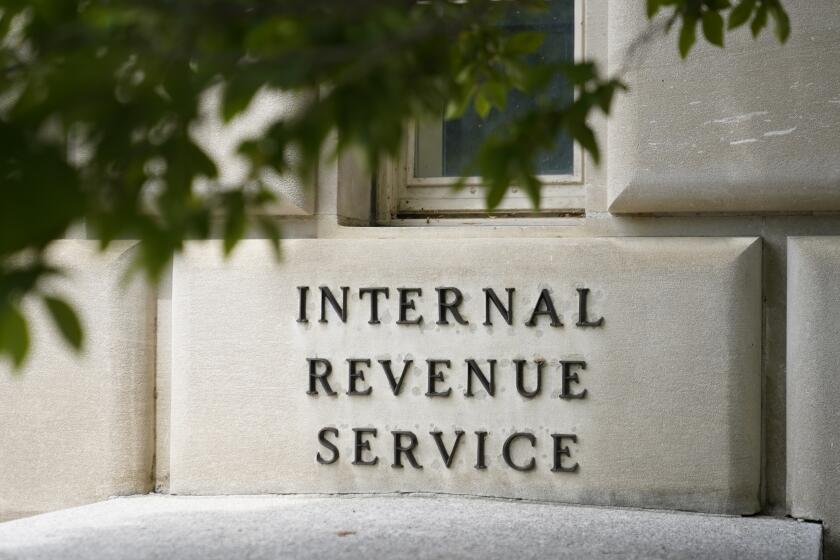From the Archives: ‘David Bowie bonds’: When Bowie needed cash, he sold royalties in advance

In this photo from August 2002, David Bowie performs at the Area2 Festival at the Verizon Wireless Amphitheater in Irvine.
- Share via
Investors craving their very own “David Bowie bonds” might have a little too much Ziggy Stardust in their eyes. Getting a backstage pass for one of the British rocker’s concerts may be a lot easier--and a lot more satisfying in the long run.
Earlier this year, investment bankers helped Bowie raise $55 million by selling royalties from songs and 25 albums, such as “The Rise and Fall of Ziggy Stardust and the Spiders From Mars.” It’s a way for the 50-year-old Bowie to raise money upfront and then pay off the bonds with royalties from his music as they come in.
The bonds, which have an average life of 10 years, were priced in February to pay investors 7.9% interest. The benchmark 30-year U.S. Treasury bond on Monday was yielding 6.90%. Prudential Insurance Co. of America, the nation’s largest insurance carrier, bought the entire issue.
Small retail investors would have almost no chance of buying a bond, as the securities don’t trade much. And if they did, is a 7.9% return worth the risks inherent in these new types of security?
“This is off the wall. It’s almost like running a pawn shop--it’s that type of collateral,” said Richard Lehmann, head of the Bond Investors Assn., an investor group in Miami Lakes, Fla. “It’s too exotic for your typical investor. You would need to understand all the risks inherent in royalties.”
Prudential has said the risks were minimal, noting that the bonds received a stellar A3 investment rating from Moody’s Investors Service. But Lehmann thinks Bowie bonds are too exotic even for Prudential.
“Some young fund managers will like the exotic stuff because they like to talk about it at their cocktail parties,” he said. “That’s why we’ll see more of it. It’s not so much the rate of return, it’s the exotic quality of it.”
Other star rock acts reportedly considering similar bonds include the Rolling Stones and Crosby, Stills & Nash. These musicians are attractive candidates because of their name recognition among baby-boomer investors and their long track records in the business, analysts said.
“We like to see a history of performance here,” said Jay H. Eisbruck, a senior analyst at Moody’s who rated the Bowie bonds.
Although those bonds had the added insurance of being backed by Bowie’s record company, even Eisbruck cautioned that such deals are mostly bought by large institutional investors and may not be suitable for individual bond buyers.
“Any investor should be educated to understand the quality of the asset backing this type of deal,” he said.
The Bowie bonds are called an asset-backed bond because the values are tied to an underlying asset. Such bonds, created in the 1980s, have seen increased demand from investors because they offer competitive returns and are relatively safe. The amount of asset-backed bonds has grown rapidly to more than $150 billion in 1996 from $1.2 billion in 1985.
Traditionally, land, mortgages and other hard assets were used to secure such bonds. In recent years, new twists include used-car sales contracts or even stock of a company, Lehmann said.
Next, Lehmann predicted, a highly paid National Football League player will want to sell $10 million of bonds based on future royalties or expected endorsements.
“They’re getting away from hard assets and just using promises to back the bonds,” he said. “A bond is just a promise anyway.”
Riaz Valani, a New York broker who helped create the Bowie bonds, is attempting to create a new bond backed by high-tech companies.
Any software company that generates a licensing revenue or royalty would be a candidate for such a bond, he said. Companies will get cash upfront that they can spend on research and development.
Though investors with stardust in their eyes may be attracted by Bowie bonds and other exotic financings, they’d be wise to look elsewhere for returns, analysts said.
“If they are more serious about investing than cocktail-party talk they will stay away,” Lehmann said.
More to Read
Inside the business of entertainment
The Wide Shot brings you news, analysis and insights on everything from streaming wars to production — and what it all means for the future.
You may occasionally receive promotional content from the Los Angeles Times.










